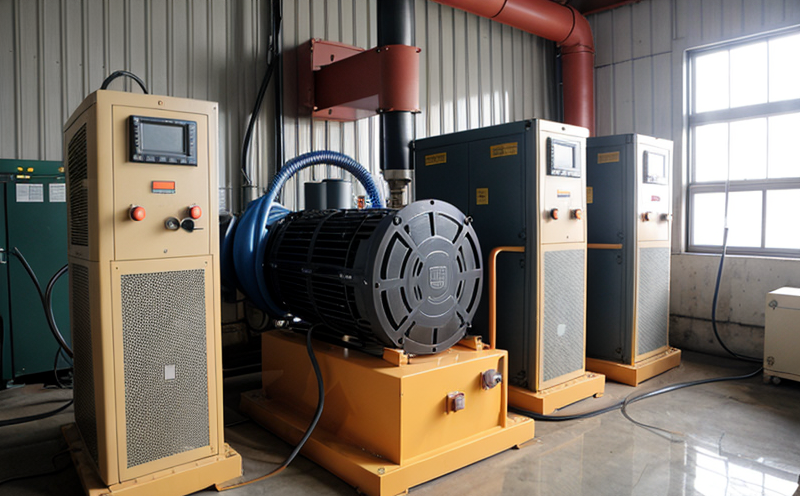ASTM E709 Magnetic Particle Testing of Generator Components
The ASTM E709 standard specifies a method for detecting surface and near-surface flaws in ferromagnetic materials using magnetic particle inspection. This testing technique is widely used to assess the integrity of critical components within power generation equipment, ensuring that any defects are identified before they can lead to catastrophic failure.
Magnetic Particle Testing (MT) involves applying a magnetic field to the component and then dusting it with iron-based particles. When there's an imperfection in the material, the magnetic flux lines are disrupted, causing the particles to cluster around the defect. This process highlights areas of concern that need further investigation.
The testing can be performed on various generator components including rotors, stators, shafts, bearings, and couplings. Each component has unique geometries and material properties which influence how the magnetic field interacts with them during inspection. For instance, rotors have complex shapes that require careful positioning to ensure all critical areas are adequately inspected.
The process involves several steps: pre-inspection preparation of the component, application of the magnetic field, application of the magnetic particles, evaluation of the results, and post-inspection documentation. Preparing for testing includes cleaning the surface thoroughly, degaussing if necessary, and ensuring all non-magnetic materials are removed or protected.
The magnetic field is typically applied using either an external magnetizing device or by passing a current through the component itself. The choice depends on the component's size and shape. For larger components like rotors, external devices such as yokes or bar magnets may be used. Smaller parts might undergo MT in a coil system. After applying the magnetic field, fine iron-based particles are sprayed onto or immersed into the component.
Once applied, any discontinuities will cause the particles to accumulate and form visible indications that indicate potential flaws within the material. These indications can be assessed visually by trained inspectors who look for specific patterns or shapes associated with different types of defects. The results are then documented according to ASTM E709 standards.
The effectiveness of this testing method relies heavily on proper technique and interpretation skills from experienced personnel. Misinterpretation could lead to false positives or negatives, emphasizing the importance of training and certification for those performing these tests.
ASTM E709 is just one part of a comprehensive quality assurance program in power generation facilities where reliability and safety are paramount. By incorporating such non-destructive testing methods into their regular maintenance schedules, plants can significantly reduce risks associated with component failures during operation.
Why It Matters
Magnetic Particle Testing is crucial for ensuring the reliability and safety of power generation equipment. Failures in critical components such as generators can result in costly downtime, potential hazards to personnel, and significant financial losses.
The early detection of flaws through MT allows for proactive maintenance strategies that extend equipment lifespan and prevent catastrophic failures. This testing ensures compliance with international standards like ISO 9712:2012, which sets out requirements for qualifications and certification of non-destructive testing personnel.
For quality managers and procurement officers involved in selecting suppliers or evaluating new technologies, MT provides a robust means to verify component integrity. By adhering strictly to ASTM E709 guidelines, manufacturers demonstrate their commitment to producing high-quality products that meet stringent industry requirements.
R&D engineers benefit from this technique as it enables them to refine designs and materials used in power generation equipment. Continuous improvement efforts are essential given the dynamic nature of the energy sector where efficiency gains and reduced environmental impact remain key goals.
Benefits
The primary benefit of ASTM E709 Magnetic Particle Testing lies in its ability to identify surface and near-surface flaws without damaging or altering the component being inspected. This makes it an ideal choice for assessing high-value assets within power generation facilities.
By catching defects early, MT helps minimize operational risks by reducing the likelihood of unexpected failures during critical operations. The non-destructive nature of this method allows repeated testing over time, enabling ongoing monitoring and maintenance planning based on real-time condition data rather than fixed intervals.
Compliance with international standards enhances reputation among stakeholders including customers, regulatory bodies, and investors. It also facilitates smoother interactions within supply chains by providing consistent quality assurance practices across different geographic locations.
Data generated from these tests serves as valuable input for predictive maintenance programs aimed at extending equipment lifecycles while maintaining optimal performance levels. Predictive analytics derived from historical MT results can inform decisions about when to schedule repairs or replacements, optimizing resource allocation and operational efficiency.
Quality and Reliability Assurance
The ASTM E709 standard plays a vital role in maintaining the highest levels of quality assurance within power generation facilities. By adhering to these standards, organizations ensure that all components undergo rigorous evaluation using consistent procedures.
Trained personnel performing MT must follow strict protocols outlined in ASTM E709, which includes proper preparation techniques for the component, precise application methods for both magnetic fields and particles, thorough examination of results, accurate documentation of findings, and clear communication of conclusions to relevant stakeholders.
The use of advanced imaging technologies during inspections can enhance accuracy further by providing detailed visualizations of potential flaws. These images serve as objective evidence supporting decisions regarding component fitness-for-service.
Data collected from multiple rounds of MT over extended periods helps establish baseline conditions for each asset, allowing tracking of changes that may indicate degradation or deterioration trends. Regular reviews and updates to maintenance schedules informed by this data contribute to maintaining peak operational performance and safety standards throughout the equipment lifecycle.





